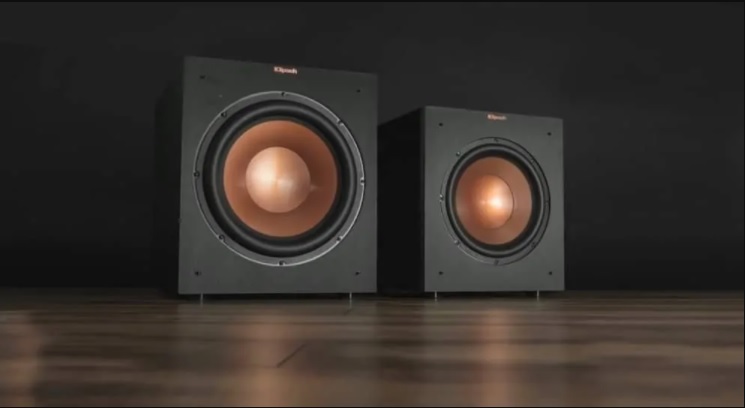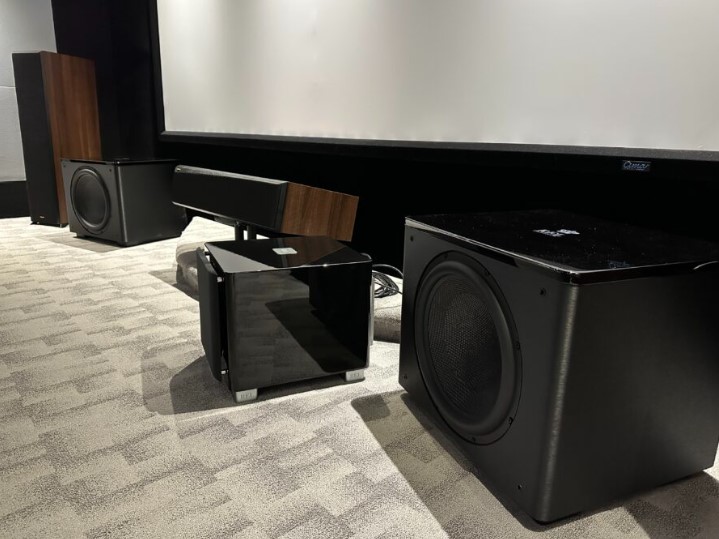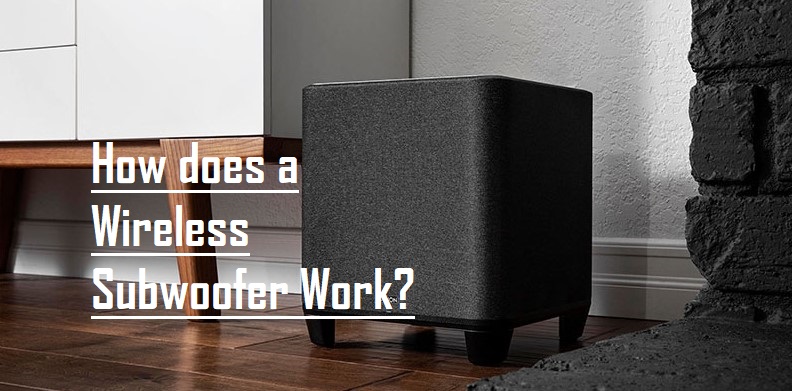A subwoofer is an essential component of any media room, but having one means dealing with another cable that will run through your wall or across the floor, right? Yes, but that was before sound systems could be connected wirelessly. This guide will teach you that what a wireless subwoofer is and that how does a wireless subwoofer work.
What’s the point of having a subwoofer?
You might wonder why you need one if you don’t listen to rap or watch action movies. Sure, a subwoofer is a bass-thumping monster, but that’s only the beginning. A good subwoofer relieves your loudspeakers of some of the work, resulting in a better overall system.

The dynamics become more engaging, the soundstage expands, and the stereo imaging improves. A subwoofer may help provide a more lively, all-encompassing sound, even if you love playing folk tunes and watching dialogue-driven indie flicks.
Front-Firing VS Down-Firing Subwoofers
Whether you have a down-firing or front-firing subwoofer will also influence placement. While there isn’t much of a difference in how each choice sounds, there are a few things to consider based on the area you’re trying to fill, specifically whether you’re putting the sub in a house or an apartment.

Where should a Subwoofer be placed?
Your subwoofer can be placed almost anyplace. However, because each room is built differently, the results will vary. There may be some trial and error required if you’re serious about achieving the best bass performance from your subwoofer. We understand, not everyone has a dedicated home theatre or listening area where they can install their subwoofer anywhere they want. Because your system is most likely in your living room, décor, furniture, and other items are likely to compete for floor space. It may be necessary to reposition some items, but finding the “sweet spot” is well worth the effort.

Point to Ponder! If you want to get the most out of a subwoofer, consider acoustic treatment in addition to positioning. Expect mediocre bass performance even if you have the greatest subwoofer in the planet in an acoustically bad environment. Acoustic panels, diffusers, and bass traps are all good ways to improve the acoustics of your room.
The Fundamentals of using a Wireless Subwoofer
A wireless subwoofer is nearly identical to a wired subwoofer, with the exception of the manner of sending audio signals.

- When using a wired sub, you only need to connect it to the amplifier via a data-sending connecting cord. These cables can be HDMI, optical, auxiliary jack, RCA, or coaxial, but they all require a physical connection to function properly.
- In the scenario of wireless subwoofers, however, this is not the case. To keep things simple, a wireless subwoofer system consists of three primary components: a receiver, a subwoofer driver, and an amplifier. Each component also has its own subcomponent.
- All you need to know is that a wireless subwoofer system operates on its own frequency and may be adjusted independently of your audio system’s loudness.
Infrared VS Radio Frequencies?
To broadcast a signal, the wireless subwoofers use either direct infrared or radio frequencies. Because radio frequencies are more susceptible to outside interference, signal loss may occur if the frequency is not appropriately tuned. Infrared technology, on the other hand, has been around for a long time and is considered more dependable.
Methods of Transmission of Wireless Subwoofers
Wireless subwoofers on the market today use one of two transmission technologies: radio frequency (RF) or infrared (IR). Each of these signal-based systems has its own set of advantages and disadvantages. It’s a good idea to think about them so you can figure out which one is best for you.
Radio Frequency (RF)
- RF systems, as the name implies, use radio signals to transfer data to a remote receiver. The data in this case is music. They typically employ radio frequencies ranging from 300 to 1000 MHz, with 900 MHz being the most common.
- Subwoofers enhance and change sound using radiofrequency (RF) technology. The subwoofer receives the input signal from the transmitter. The signal is strengthened and turned into mechanical energy during amplification. The mechanical energy is then sent to the subwoofer, where it is converted to acoustic energy.
- Amplification is accomplished with the use of subwoofer components (such as amplifiers, filters, power supplies, and drivers).
- A Consideration: This kind of transmission is ideal for subwoofers that do not have a direct line of sight to the receiver. Metal, a few types of polymers, electronics, and cement are all prone to disrupt or absorb these signals.
Infrared System (IR)
- To deliver audio signals to the remote receiver, IR systems use light broadcasts. They do the same thing with light wavelengths and are suitable for submarines that are in a small region with the receiver and transmitter within 20 ft of each other.
- Because infrared subwoofers do not produce heat like traditional woofers, they are incredibly efficient. The slot loaded construction of infrared subwoofers eliminates the need for air vents or dust caps. They don’t need to be cooled because they don’t produce heat, which makes them extremely efficient.
- A heat sensor and an infrared LED light are included with these subwoofers. The heat sensor has two key functions: first, it provides electricity to the LED, and second, it detects vibration. The LED turns on when the sensor senses vibration and turns off when the sensor does not detect vibration.
- When the LED is turned on, it illuminates the cone’s surface, allowing it to make sound. When the LED is turned off, the cone absorbs heat from its surroundings, returning to its previous shape and producing the pulsing sound.
- A Consideration: There should be no physical barriers between the transmitter and the receivers. Wireless communications will not be possible otherwise. All solid materials, with the exception of translucent things, are capable of blocking IR signals. They can be blocked by colorful translucent things like stained glass.
Bluetooth Technology
Most Bluetooth wireless subwoofer models work in the same way as other Bluetooth speakers.
- After you’ve decided on a subwoofer, make sure your phone’s bluetooth connection is turned on and set to “pair with device.” Then, after following the pairing instructions, you’ll be able to play your music in no time.
- Only the music signal from the phone to the subwoofer is transmitted over Bluetooth.
- The range of the Bluetooth signal is limited. It could be roughly 33ft (10m)–20ft (6m), or possibly less, depending on your phone/device.
- This means you can usually play music from your phone or tablet from your bluetooth subwoofer’s position.
Qualcomm aptX Technology
- Bluetooth is excellent for setting up a wireless connection, but it isn’t well-suited for audio transmission. This is one of the reasons why many subwoofers experience considerable delay when employing this form of signal transmission. Qualcomm aptX is based on the same structure as Bluetooth, but it has been fine-tuned for audio connections.
- Another benefit of aptX over other connections is that it can connect to transmitters that only support Bluetooth, making it compatible with the majority of our audio products.
- A Consideration: Many people believe it is the greatest option for wireless subwoofers due of its low latency, solid connection, reduced susceptibility to interference, and lack of a direct line of sight requirement.
Wi-Fi Technology
- Many of us are familiar with devices that use our home’s WiFi connection to connect to the Internet and work with a smartphone app. Did you know, though, that you can now add WiFi to your subwoofers?
- The wireless subwoofer connects to your home’s WiFi and lets you select the music you wish to listen to. The subwoofer is then ready to play after selecting the audio source using the WiFi equipped remote control or an app on your smartphone.
- Without the need for a wired connection, you can enjoy all of the low-frequency sensations of your music anywhere in your home with a WiFi subwoofer.
- The wireless subwoofer will revolutionize the way you listen to music at home for the rest of your life. You can wirelessly stream music from your phone or tablet and listen to it from anywhere in the room. You can also use a Bluetooth-enabled device, such as your smartphone, to stream music wirelessly.
Advantages and Disadvantages of using a Wireless Subwoofer
Advantages
- When throwing a party or other social gathering, you’ll need speakers who can make your guests’ experience unforgettable. Not everyone, however, has the financial means to buy and install the greatest speakers.
- So, is a good subwoofer out of your price range? Not in the least! If you’re on a budget, compatible wireless subwoofers are your best bet.
- Because they are wireless, they save you money on wiring and other installation charges that you would otherwise have to pay. The subwoofers use radio frequencies to send high-quality bass signals through barriers. The sound quality is only limited by the speaker’s capabilities. It has the ability to fill a huge room with sound with ease.
Disadvantages
- The simplest explanation for how wireless subwoofers operate is that they transport audio from your AV receiver to the subwoofer using radio signals.
- Your AV receiver is connected to a dedicated transmitter, and an antenna in the subwoofer receives and broadcasts the signal. With the exception of the power cord, a wireless subwoofer has no cables connecting the two components.
- Your AV receiver transfers the audio signal to the wireless transmitter, which then broadcasts it to the subwoofer’s antenna. The signal is then delivered to the amplifier, which generates an electrical signal that is then routed to the woofer, which vibrates the air to produce sound.
Conclusion
We described what a wireless subwoofer is and what benefits it will bring you when compared to wired alternatives in this wireless subwoofer guide. To understand how does a wireless subwoofer work, you must first understand the devices that broadcast IR or RF signals. These are a transmitter, a receiver, a subwoofer, and a repeater at times.
Here’s the list to some of the best wireless subwoofer systems in the market for you:
- Klipsch SPL-150 – Premium
- Samsung SWA-W700
- Sonos Sub Gen 3
- Audioengine S8 Powered Home Subwoofer
- Roku Wireless Bass Pro
- Klipsch R-12SWi
- Bose Bass Module 700
Check out more of the blogs section
- How Does Wireless Surround Sound Work?
- 2-Way vs 3-Way Car Speakers Which is Better?
- Are Component Speakers Better?
- Apple Vision Pro and vision OS User Instructions
- Exploring Apps of Apple Vision Pro and Vision OS
- How Long do Speaker Crossovers Last?
- How to Install a Dishwasher
- How to Install Midea Countertop Dishwasher
FAQs – How does a Wireless Subwoofer Work
Are Wireless Subwoofers Worth It?
Wireless subwoofers eliminate the hassle of cables while delivering deep, rich bass. They offer flexibility in placement and are ideal for clutter-free setups.
Do Wireless Subwoofers Need to Be Plugged In?
Yes, wireless subwoofers need to be plugged into a power outlet to function, even though they receive audio signals wirelessly, often via Bluetooth.
Does a Wireless Subwoofer Need Power?
Despite being wireless, a subwoofer still requires a power cable to operate. The wireless aspect typically refers to the audio signal transmission, not the power source.
How Do You Hook Up a Wireless Subwoofer?
To connect a wireless subwoofer, you usually connect the audio cable to a wireless transceiver and plug the transceiver into your TV’s USB port. Then, position the subwoofer and connect it to a power outlet.
Which is Better: Wired or Wireless Subwoofer?
Wired subwoofers provide a direct and reliable connection with minimal latency. Wireless subwoofers offer more flexibility in placement, making them convenient for clutter-free setups.
Where is the Best Place to Put a Wireless Subwoofer?
The best place for a subwoofer is often in one of the front corners of the room. This position uses the room’s walls to enhance and direct the bass for better sound quality.
Can I Use a Wireless Subwoofer with Any Soundbar?
You can’t connect just any subwoofer to any soundbar. The subwoofer must be compatible with the soundbar, often requiring them to be from the same brand.
How Do I Convert My Wired Subwoofer to Wireless?
To convert a wired subwoofer to wireless, connect a transmitter to your AV receiver’s subwoofer pre-out, and then connect a wireless adapter to the subwoofer using the provided cables.

